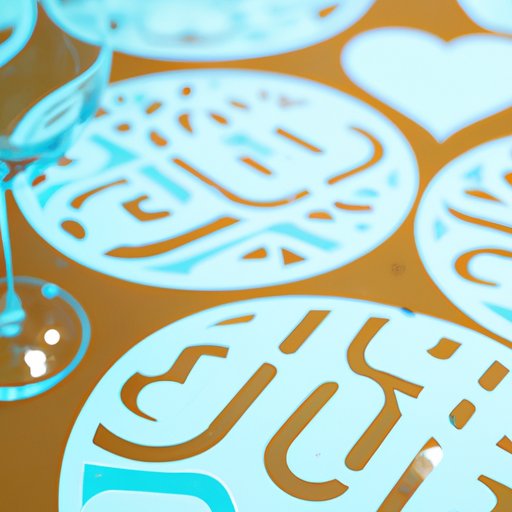
I. Introduction
Etching glass can be a daunting task for beginners, but with the right guidance and materials, it can be a fun and rewarding experience. This article will provide step-by-step instructions on how to etch glass, tips and tricks for beginners, ideas on personalizing glassware, using stencils for etching, business opportunities that arise from etching, and advanced etching techniques.
II. A step-by-step guide on etching glass
Before beginning to etch glass, it is essential to have all the required materials at hand. The etching materials include glass, etching cream, gloves, stencil, painter’s tape, sponge, and water. There are two types of etching methods: the cream or paste method and the sandblasting method. The cream method is easier and more affordable for beginners, the step-by-step procedure involves:
- Clean the glass surface with soap and water and dry thoroughly.
- Using painter’s tape, cover the area on the glass that you want to preserve, and then place the stencil on the tape.
- Put gloves on and apply the etching cream on the exposed surface of the glass using a sponge brush. Make sure to cover the exposed area in a thick layer.
- Leave it on for the time recommended on the packaging, typically between five to ten minutes, then rinse off with water.
- Peel off the stencil and tape, and then dry the glass thoroughly.
III. Tips and Tricks for Beginners
Starting with etching glass can be tricky, but here are some tips and tricks to get started and avoid frustration:
- Practicing on a scrap glass material to perfect the technique is very important.
- Wear gloves when applying etching cream to avoid skin irritation.
- Use a stencil instead of attempting freehand etching for precision.
- Do not touch the glass with your fingers while etching to avoid leaving fingerprints and smudges.
- Clean the sponge brush thoroughly after etching each glass, or use a new one for each glass to avoid mixing residues.
IV. Personalizing Glassware
Etching glassware can add a personal touch on a budget. Here are some ideas to add a personalized touch:
- Wedding favors: Personalized champagne glasses, souvenir glass mugs with the couple’s names, and wedding date etched onto them.
- Customized gifts: Personalized glassware gift for birthdays, baby showers, retirement parties, among others.
- Business logos: Customized designs etched onto glassware for advertising and branding purposes.
V. Using Stencils for Etching
Stencils can be purchased online, or you can make them yourself using a craft cutting machine like a Cricut using a vinyl stencil. For beginners, purchasing stencils that match their purpose is a good idea. Here is a tutorial on how to use stencils:
- Clean the glass surface you want to etch and dry it well.
- Place the stencil designed with a previously cut adhesive on the glass.
- Apply the etching cream over the stencil using a sponge brush.
- Leave the etching cream on the glass for five to ten minutes.
- Wash off the etching cream using warm water.
- Remove the stencil from the glass.
- Wash the remaining etching cream and enjoy your beautiful design.
VI. Etching Business Opportunities
Etching glass is a creative and fun activity that can be turned into a business. Here are some examples of business opportunities that arise from etching glass:
- Customized glassware for special occasions like weddings, birthdays, and anniversaries.
- Etched glassware as corporate gifts and official business events.
- Etching business logos and designs onto glassware for branding purposes.
VII. Using Etching Kits
Etching kits have all the required materials included, making it easier to etch glass for beginners. Before purchasing an etching kit, ensure it comes with complete etching materials and a stencil. Here is a tutorial on how to use etching kits effectively:
- Choose the design stencil you want to etch onto the glassware.
- Place the stencil on the glassware and secure using painter’s tape.
- Using gloves, apply the etching cream on the stencil using a sponge brush.
- Leave the etching cream on for five to ten minutes.
- Rinse off the etching cream using warm water.
- Remove the stencil and tape from the glass.
- Finally, rinse off any remaining etch cream and dry the glass.
VIII. Advanced Etching Techniques
Advanced etching techniques include 3D etching, multi-layer etching, and reverse etching. Here’s how to create stunning designs:
- 3D etching involves using an etching cream that gives a raised texture on the glass.
- Multi-layer etching involves etching the glass in multiple layers, etching each layer separately to achieve depth in the design.
- Reverse etching is when the stencil is placed on the back of the glass, which means the design remains protected when the glass is used.
IX. Conclusion
Etching glassware does not have to be daunting for beginners. With the right materials and techniques, it can be a fun and rewarding experience. This article has outlined the materials required for etching glass, different etching techniques, and tips for beginners. We have explored personalizing glassware, using stencils for etching, etching business opportunities, and advanced etching techniques, all designed to take your etching game to the next level. Hence, we encourage you to give it a try and create beautiful, customized glassware.
Final thoughts and recommendations: Etching glass is an art that requires patience, attention to detail, and creativity. It is a cost-effective way of personalizing everyday glassware with a personal touch. We recommend trying out the cream method as a beginner etcher, practice and master the skill with simple and easy design patterns. Once comfortable with the skill and process, venture into using stencils and etching kits. Finally, let your imagination run wild and challenge yourself by trying out advanced techniques.




